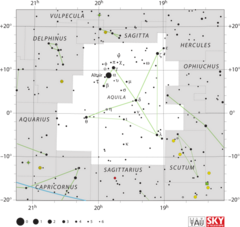Astronomy:Upsilon Aquilae
| Observation data Equinox J2000.0]] (ICRS) | |
|---|---|
| Constellation | Aquila |
| Right ascension | 19h 45m 39.94732s[1] |
| Declination | +07° 36′ 47.3626″[1] |
| Apparent magnitude (V) | +5.889[2] |
| Characteristics | |
| Spectral type | A3 IV[3] |
| U−B color index | +0.09[4] |
| B−V color index | +0.18[4] |
| Astrometry | |
| Radial velocity (Rv) | −29.9±2.0[5] km/s |
| Proper motion (μ) | RA: +53.492[1] mas/yr Dec.: +0.021[1] mas/yr |
| Parallax (π) | 18.6614 ± 0.0975[1] mas |
| Distance | 174.8 ± 0.9 ly (53.6 ± 0.3 pc) |
| Absolute magnitude (MV) | +2.24[6] |
| Details | |
| Mass | 1.81±0.02[7] M☉ |
| Luminosity | 10.5[6] L☉ |
| Surface gravity (log g) | 4.21[2] cgs |
| Temperature | 7,906[2] K |
| Metallicity [Fe/H] | –0.05[2] dex |
| Rotational velocity (v sin i) | 42[7] km/s |
| Age | 180[8] Myr |
| Other designations | |
| Database references | |
| SIMBAD | data |
Upsilon Aquilae, Latinized from υ Aquilae, is the Bayer designation for a star in the equatorial constellation of Aquila. With an apparent visual magnitude of +5.91[4] it is a faint star but visible to the naked eye from suburban skies. It has an annual parallax shift of 18.66 mas,[1] indicating a distance of around 175 light-years (54 parsecs). The star is drifting closer with a radial velocity of –30 km/s.[5]
Upsilon Aquilae is a subgiant star with a stellar classification of A3 IV.[3] The outer atmosphere is radiating energy into space with 10.5[6] times the Sun's luminosity from its photosphere at an effective temperature of 7,906 K,[2] which gives it the white-hot glow of an A-type star. It is 180[8] million years old with 1.8 times the mass of the Sun and is spinning relatively quickly with a projected rotational velocity of 42 km/s.[7]
References
- ↑ 1.0 1.1 1.2 1.3 1.4 1.5 Brown, A. G. A. (August 2018). "Gaia Data Release 2: Summary of the contents and survey properties". Astronomy & Astrophysics 616: A1. doi:10.1051/0004-6361/201833051. Bibcode: 2018A&A...616A...1G. Gaia DR2 record for this source at VizieR.
- ↑ 2.0 2.1 2.2 2.3 2.4 Soubiran, C. et al. (June 2010), "The PASTEL catalogue of stellar parameters", Astronomy and Astrophysics 515: A111, doi:10.1051/0004-6361/201014247, Bibcode: 2010A&A...515A.111S.
- ↑ 3.0 3.1 Cowley, A. et al. (April 1969), "A study of the bright A stars. I. A catalogue of spectral classifications", Astronomical Journal 74: 375–406, doi:10.1086/110819, Bibcode: 1969AJ.....74..375C.
- ↑ 4.0 4.1 4.2 Johnson, H. L. et al. (1966), "UBVRIJKL photometry of the bright stars", Communications of the Lunar and Planetary Laboratory 4 (99): 99, Bibcode: 1966CoLPL...4...99J.
- ↑ 5.0 5.1 Wilson, Ralph Elmer (1953), "General catalogue of stellar radial velocities", Washington (Carnegie Institution of Washington): 0, Bibcode: 1953GCRV..C......0W.
- ↑ 6.0 6.1 6.2 Anderson, E.; Francis, Ch. (2012), "XHIP: An extended hipparcos compilation", Astronomy Letters 38 (5): 331, doi:10.1134/S1063773712050015, Bibcode: 2012AstL...38..331A.
- ↑ 7.0 7.1 7.2 Zorec, J.; Royer, F. (2012), "Rotational velocities of A-type stars. IV. Evolution of rotational velocities", Astronomy & Astrophysics 537: A120, doi:10.1051/0004-6361/201117691, Bibcode: 2012A&A...537A.120Z.
- ↑ 8.0 8.1 De Rosa, R. J. et al. (2014), "The VAST Survey - III. The multiplicity of A-type stars within 75 pc", Monthly Notices of the Royal Astronomical Society 437 (2): 1216–1240, doi:10.1093/mnras/stt1932, Bibcode: 2014MNRAS.437.1216D.
- ↑ "* ups Aql". SIMBAD. Centre de données astronomiques de Strasbourg. http://simbad.u-strasbg.fr/simbad/sim-basic?Ident=%2A+ups+Aql.
External links
 |


